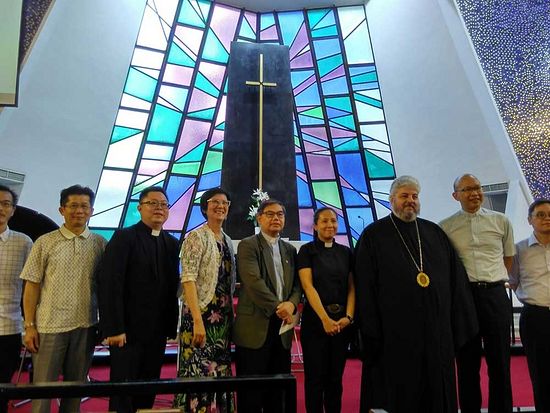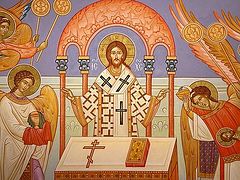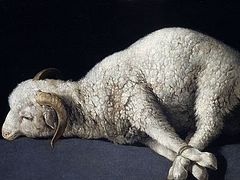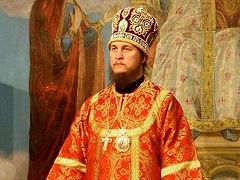Source: Orthodox Metropolinate of Hong Kong and South East Asia
June 26, 2016
Metropolitan Nektarios of Hong Kong and South East Asia delivered a speech on the Sacrament of the Holy Eucharist at the second ecumenical seminar which was held on Sunday, June 26, 2016, in Hong Kong.
The subject of the second ecumenical seminar is the Holy Eucharist. The thoughts that follow do not aspire nor claim to cover the subject in full. We will try, however, to present briefly and clearly the teaching of the Orthodox Church on the Holy Eucharist.
The Holy Eucharist is the centre of the worship and life of the Church. Early tradition saw in the Eucharist the summation of the whole mystery of Christ, and not simply one part or aspect of it.
The Holy Eucharist expresses, reveals and accomplishes within history the Church itself, not simply as it is, but principally how it will be, when the Kingdom of God prevails. In Orthodox Tradition the Holy Eucharist is an icon of the Kingdom of God: an icon of the future and not of the past. In the Holy Eucharist the Church moves from the present world and history, and lives and moves in the eschata, in the Last Times. The Church’s true home is the Kingdom of God and not this world. And precisely because the Holy Eucharist is an icon of the Kingdom of God, it must be celebrated with splendour. That is why the Typikon [or liturgical guide] specifies that the Holy Eucharist is to be celebrated on Sundays and Saints Days, for these days are joyful. It is specifically forbidden for a complete Liturgy to be celebrated during fasting periods.
It is not by accident that in the ecclesiastical literature, we find no definition of the Church until the time of scholasticism. The Church was a lived reality that was so obvious and well-known to all, that any theoretical description of it was superfluous.
This tangible and specific reality was from the beginning identified in the consciousness of the Church with the Synaxis [or gathering] of the Holy Eucharist. There are many examples in the literature that support this view. I will quote only one. In Chapters 11 to 14 of St Paul’s first Epistle to the Corinthians the term ‘Church’ is used to mean the local church, and specifically the Synaxis or gathering of the local church to celebrate the Holy Eucharist.
1. The institution of the Holy Eucharist
Christ himself gave to us the Sacrament of the Holy Eucharist on the evening of the Mystical Supper, a few hours before his voluntary Passion. The Lord blessed the bread and wine, offered it to his disciples, and asked them to do the same. “Do this in remembrance of me.”
The Holy Eucharist is first of all the remembrance of Christ. But it is not a simple act of remembrance. Christ himself is present. He calls us to live with Him his life, the life of the God-man, to live his sacrifice and Resurrection. He offers to us, and calls us to commune of, His Body and Blood. “This is My Body, which is broken for you for the remission of sins. This is My Blood, which is shed for you and for the many, for the remission of sins.”
During the Eucharist we have before us no longer bread and wine, but the Body of Christ, which is broken into many for us, and the Blood of Christ which is shed for us, for the remission of our sins. When we take communion we become “of one body and blood with Christ”, “Christ-bearers”, “God-bearers”. And since we become one with Christ “mystically”, we become one with all Christians, we all become one body, because we have all taken of the same Body, Christ. Union with Christ makes our existence—from being animal—divine. It leads us into the beauty and glory of the Kingdom of God. The Holy Eucharist brings Paradise into our life.
2. Types of Liturgy
By the 5th Century AD three rites had been established.
The earliest of these is the Liturgy of St James the Brother of the Lord, the first Bishop of Jerusalem. Nowadays it is celebrated two times a year, on 23 October, the Feast Day of St James, and on the first Sunday after Christmas.
Due to the length of this Liturgy, St Basil the Great, Bishop of Caesarea, wrote a new Liturgy, which now bears his name. It is celebrated ten times a year, on the five Sundays of Holy and Great Lent, on Holy Thursday, Holy Saturday, Christmas Eve, Theophany and on the First of January, the Feast Day of St Basil.
St John Chrysostom shortened the Liturgy of St Basil. The Liturgy of St John Chrysostom is the most commonly celebrated and well-known Liturgy.
During Holy and Great Lent, on weekdays the Pre-sanctified Liturgy, as it is known, is celebrated. If called a Liturgy, it is not in actual fact a Liturgy because it does not contain the consecration of the bread and wine. The service is celebrated so that the believers commune of bread that has been consecrated at the Liturgy on the previous Sunday. Due to the mournful character of Holy and Great Lent the Typikon does not permit the celebration of the Holy Eucharist on weekdays.
3. The visible elements of the Sacrament
The visible elements that are used in the Holy Eucharist are bread and wine, and a small quantity of water. These elements are sanctified through the invocation of the Holy Spirit, which immediately follows the words of institution and Christ’s words ‘Do this in remembrance of me.’ Despite the fact that the Holy Eucharist is a Sacrament that is offered by the whole Church, the celebrant in the Sacrament, as the instrument and icon of Christ the Great Priest who unifies and offers, is the Bishop or the Priest served by a Deacon. The participants in the Holy Sacrament are all those who have been baptised, regardless of their age, who are obliged to examine their conscience and in this way to participate in the Holy Sacrament with sincere repentance.
From the very outset the wine was mixed with water, which was in accordance with Palestinian tradition, whereby wine was not drunk without being mingled with water. This is the act in the Liturgy which is referred to in the Apostolic Orders, according to which the Lord mixed wine and water in the Cup and, sanctifying them, gave them to the Apostles saying, “Drink from this.” This reminds us also of the piercing of the Lord’s side when He was on the Cross, and when from his side “at once flowed blood and water”.
St Cyprian, Bishop of Carthage, saw this mixing of wine with water as the symbolic union of Christ with His Church. He observed that, when the water is poured into the Chalice, the people are united to Christ. He explained that, when someone uses only wine in the Eucharist, then the Blood of Christ excludes the believers, while, if there is only water in the Cup, that would exclude Christ.
4. The celebrants of the Sacrament of the Eucharist
The Bishop or Priest is the only celebrant of the Holy Sacrament. The Lord entrusted this Sacrament to his holy Disciples and Apostles and gave them the Command “Do this in remembrance of me.” The exhortations, “take, eat” and “drink of this” were addressed to the holy Apostles. This is borne out by the practices and tradition of the Orthodox Church.
Of course we must stress that the Bishop or Priest who stands before the holy Altar performs the actions, but that God acts through him.
In the Didache or the Teaching of the Twelve Apostles we find the command: appoint for yourselves Bishops and Deacons worthy of the Lord, men who are humble and not avaricious, men who are true and approved because they too will fulfil for you the ministry of the Prophets and Teachers.
St Ignatius, Bishop of Antioch, clearly proclaimed that only the Eucharist that is celebrated under the authority of the Bishop (or whomsoever the Bishop may ordain) should be considered valid. Wherever the Bishop appears, there let the people be; just as wherever Jesus Christ is, there is the catholic Church. Neither Baptism nor agape feasts may be celebrated without the Bishop. Whatever he approves of is pleasing to God, so that everything the ecclesiastical body does may be true and valid.
Lay people are not permitted to celebrate the Holy Sacrament of the Eucharist, although they are allowed to carry the holy Gifts in exceptional circumstances.
5. The nature of the Sacrament of the Holy Eucharist
The Holy Eucharist is a sacrament, or mystery, and sacrifice. It is a sacrament according to which, through the prayer of the priest, the grace of the Holy Spirit descends and changes the natural elements of bread and wine into the body and blood of Christ. This is a great mystery, which is inexplicable and incomprehensible. It is the essence of the natural elements that is changed and altered. That is the elements lose their own essence, and the immaculate body and precious blood of Christ take the place of their essence. Of course they keep their accidents, everything surrounding the essence, that is their natural qualities of weight, colour, smell, taste and, in the case of the wine, acidity. The person who takes communion accepts the very body and blood of Christ, that same body of He who was born, increased, suffered on the Cross, rose from the dead and, deified, ascended into heaven. He communes of the whole human nature of the Lord and of his divinity, which is indivisibly united to his human nature.
The Holy Eucharist is at the same time also a sacrifice. It is the sacrifice of the Cross itself, an anticipation of which the Saviour performed at the Mystical Supper of Holy Thursday. It is the same sacrifice with that of the Cross; however it is offered as a bloodless sacrifice, while the sacrifice of the Cross was not. Likewise, while the sacrifice on the Cross happened once for all time for the abolition of sin and death, the sacrifice of the Eucharist happens repeatedly, with the aim of applying the salvatory benefits of this great sacrifice to the body of the believers. At the sacrifice of the Eucharist both he who offers the sacrifice and the sacrificial victim are Christ himself, who is offered through the hands of the Priest.
6. The use of the term μετουσίωση or Transubstantiation (Transsubstantiatio)
This term is used principally by the Roman Catholic Church. It is not wrong. Its meaning corresponds to the Greek terms used by the Orthodox Church: μεταβολή (trans-formation or simply change), μεταποίηση (trans-making) and μεταστοιχείωση (trans-mutation). When Orthodox theologians use the term transubstantiation they ascribe to it the meaning of change. Usually, however, the use of the term is avoided in the Orthodox Church, since it brings to mind scholastic cavilling about the distinction between essence and accidents, based on Aristotelian philosophy. The terms ‘trans-making’ and ‘change’ are preferable. Orthodox believers do not dwell overly on how precisely the bread and wine change into the Body and Blood of Christ. It is enough for them to believe in the omnipotence of God and in this dread and incomprehensible divine mystery.
7. The permanence of the change
The sanctified elements, the bread and wine, remain sanctified after the end of the Divine Liturgy. That is why at the end of every Divine Liturgy the Priests and Deacons who have served consume the sanctified elements.
In the early Church, the Bread and Wine that had been sanctified and changed into the Body and Blood of Christ, were brought to those who had been absent from the Divine Liturgy, especially to those in prison, during the times of persecution. It was common practice for believers to keep the Holy Gifts in their homes, so that they could take communion every day.
During Holy and Great Lent the complete Liturgy was permitted only on Saturdays and Sundays. According to the early tradition of the Presanctified Gifts, the Body and Blood of Christ, which had already been sanctified during the Liturgy on the previous Sunday, were offered on Wednesdays and Fridays.
St Cyril of Alexandria was opposed to the idea that the elements of the Eucharist lost their sanctified grace by the next day. He called this view folly, because the Body of Christ is incorruptible. The power of the blessing and the life-giving grace are constant.
8. The use of leavened bread in the Holy Eucharist
Leavened bread and wine mixed with water are used in the Divine Eucharist. As we have already said, the wine is mixed with water in remembrance of the flow of blood and water from the side of Christ when on the Cross he was pierced with a lance (John 19:34). The Orthodox Church uses leavened bread, while the Roman Catholic Church and others use unleavened bread. The Orthodox Church uses leavened bread, because when Christ, a few hours before his death on the Cross, ate his last Passover Meal with his Disciples, on the evening of the Thursday, when he instituted the sacrament of the Divine Eucharist (on the 14th day of Nisan) he used leavened bread, because unleavened bread was not yet to be used. Unleavened bread was consumed on the next day, the first day of the Jewish Passover (15th day of Nisan), and for seven days in total.
9. Are baptised infants permitted to take Communion?
Of course they are permitted, since they have been baptised, and they no longer have original sin and have been re-born spiritually, and they have received the Holy Chrism, which sealed the gifts of their baptism. There is no reason why their pure and gentle nature should be deprived of the benefits granted by Holy Communion.
10. Are lay people permitted to commune of both elements in the Orthodox Church?
The Orthodox Church does not accept the theory of concomitantia and it does not deprive laypeople from the Holy Chalice.
The Apostolic Tradition requires that both the Clergy and laypeople commune of both the sanctified elements, of both bread and wine.
When Christ instituted the Divine Eucharist, he made particular reference to his blood, saying, “Drink of this all of you.” All of you clearly includes laypeople.
11. When are the Holy Gifts sanctified?
After the words “Thine own of thine own”, when the priest reads the prayer of sanctification, calling on the Holy Spirit to descend and, through the grace of the Holy Spirit, to change the natural elements of bread and wine into the Body and Blood of Christ. This is, of course, the most holy moment in the Divine Liturgy. When the Liturgy takes place on a Sunday, the believers are not allowed to kneel down, because Sunday, being the day of the remembrance of Christ’s Resurrection, is a day of rejoicing (Canon 90, Council in Trullo). On weekday Liturgies, on Saint’s Days, kneeling is permitted.
The prayer of sanctification is found in all the ancient typika or liturgical books of the Divine Liturgy.
12. When someone receives only a small portion of the sanctified divine gifts, does he commune of the whole Christ?
Yes. He communes of the whole body and blood of the Lord, the whole of his humanity, and the divinity of the Lord. This does not depend on the quantity of the bread and wine he receives. Christ is present even in the smallest quantity of the Divine Eucharist. Both the Priest who consumes the whole of the remaining elements after the believers have taken communion, as well as the believer who receives only a small quantity, commune of the same Christ.
As in a great mirror the whole sun is reflected, so if we break the mirror into pieces, in each of these pieces the same sun will be reflected. In the same way Christ is present in the whole quantity as well as in a small amount of the sanctified gifts. Similarly, he is present in all the Holy Chalices where the sacrament of the Divine Eucharist is celebrated. This is the greatest miracle of God!
13. Epilogue
The Divine Liturgy is the communion of God with man. God, who came down to earth, left us as his inheritance his body and blood so that we could eat and drink of them and commune through them with Him in the most perfect way possible. The Divine Liturgy shows us Christ, it leads us to Him, and unites us with Him. From the very first the Divine Liturgy was considered to be “in Christ” and it never lost this orientation. If it loses it, it will no longer be the Divine Liturgy of the Church.
Thank you very much!





